Photos By:: Adil Arora
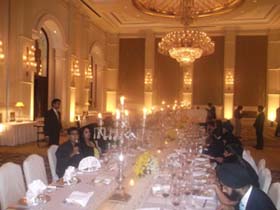 If the ambience, arrangements and service at the Ballroom of Hotel Leela Chanakyapuri, Delhi, were considered product packaging - for the vertical tasting of 14 top quality wines from the Tuscan biodynamic estate of Querciabella- one must laud the hotel for doing an excellent job and impressing the 40+ trade people with the packaging. The entire ball room was converted into a majestic dining room with one long table spread across the room, with pristine white linen and drapery, and sparkling, impressive tableware giving an elegant appearance. It was further reinforced by a welcome at the entry with perfectly chilled and served champagne from the house of Philippe Gonnet, also imported by Wine Park. A little confusing was the medium to full bodied red wine that was also circulating- Mongrana 2009. If the ambience, arrangements and service at the Ballroom of Hotel Leela Chanakyapuri, Delhi, were considered product packaging - for the vertical tasting of 14 top quality wines from the Tuscan biodynamic estate of Querciabella- one must laud the hotel for doing an excellent job and impressing the 40+ trade people with the packaging. The entire ball room was converted into a majestic dining room with one long table spread across the room, with pristine white linen and drapery, and sparkling, impressive tableware giving an elegant appearance. It was further reinforced by a welcome at the entry with perfectly chilled and served champagne from the house of Philippe Gonnet, also imported by Wine Park. A little confusing was the medium to full bodied red wine that was also circulating- Mongrana 2009.
Mongrana 200 IGT Toscana
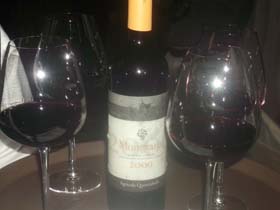 Before the big act there was the warming act thrown in, apparently as the unofficial launch of Mongrana, a Super Tuscan blend of 50% Sangiovese, 25% Cabernet Sauvignon and 25% Merlot from their relatively new estate bought in 2000. Born in 2005, it is a perfect wine for most Italian foods. The 2009 vintage was fresh, fruity and intense, though yet slightly astringent and as Giorgio Fragiacomo, the visiting export manager explained, does not use any animal products so is perfect for the vegans and vegetarians who would enjoy this wine with soft and juicy tannins with their pizza, pasta or even Indian dishes like baingan ka bharta or mushroom mutter masala. Before the big act there was the warming act thrown in, apparently as the unofficial launch of Mongrana, a Super Tuscan blend of 50% Sangiovese, 25% Cabernet Sauvignon and 25% Merlot from their relatively new estate bought in 2000. Born in 2005, it is a perfect wine for most Italian foods. The 2009 vintage was fresh, fruity and intense, though yet slightly astringent and as Giorgio Fragiacomo, the visiting export manager explained, does not use any animal products so is perfect for the vegans and vegetarians who would enjoy this wine with soft and juicy tannins with their pizza, pasta or even Indian dishes like baingan ka bharta or mushroom mutter masala.
Querciabella Batàr
Batar has seen 24 vintages undergoing name and grape changes during this period. The first wine came out in 1988 as Bâtard-Pinot. It featured a blend of two Pinots - Bianco and Grigio. In 1992 the name was shortened to Bâtard as Chardonnay had been added to the blend. This created a legal conflict and confusion because of the existing Grand Cru wines - Bienvenues-Bâtard-Montrachet, Criot-Bâtard-Montrachet and Bâtard-Montrachet in the villages of Puligny Montrachet and Chassagne Montrachet in Burgundy. The name of the equal blend of Pinot Bianco and Chardonnay had to be changed to the present one in 1995.
Fragiacomo was perhaps quoting Gambero Rosso when he said that Batàr was the best Italian white wine. It has been praised to the hilt by noted wine writers. Hugh Johnson called one of the earlier vintages of Batàr a dream of a white in his Pocket Wine Book. Robert Parker considers it sublime. Even Jancis Robinson is really enamoured with it.
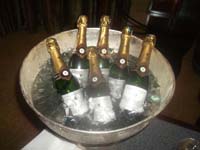 If Batàr tastes like a Premier or Grand Cru Burgundy in a Tuscan bottle, it is reflective of the love of Querciabella’s founder, late Giuseppe Castiglioni who had returned after amassing wealth in steel production in Mexico and was an avid collector of French wines and a great Burgundy wine lover. He found North facing slopes on schist and started working 40 years ago with Giacomo Tachis, the winemaker for the iconic Sassicaia, to help produce the best white wine possible. Fermented in 100% French barriques and aged for about 20 months before release, it needs to lay up for a minimum of 42 months and optimally 4 years or even more before opening the bottle. If Batàr tastes like a Premier or Grand Cru Burgundy in a Tuscan bottle, it is reflective of the love of Querciabella’s founder, late Giuseppe Castiglioni who had returned after amassing wealth in steel production in Mexico and was an avid collector of French wines and a great Burgundy wine lover. He found North facing slopes on schist and started working 40 years ago with Giacomo Tachis, the winemaker for the iconic Sassicaia, to help produce the best white wine possible. Fermented in 100% French barriques and aged for about 20 months before release, it needs to lay up for a minimum of 42 months and optimally 4 years or even more before opening the bottle.
The bright golden coloured 2007 Batàr was still a bit closed but delicious with good oak fruit balance in the full bodied wine that had a balanced acidity and full of fruit concentration. The 2004 was drinking better with distinct minerality. The company had gone fully biodynamic in 2002 and the wines tasted purer and more mineral after that, as Giorgio explained. The 2002 which was from a poor vintage, had been procured from the personal cellars of the owners. It showed what a good winemaker could do even in a poor year. I found the 2000 tasting the best and with perfect balance. The 1998 was a good example of how a Batàr can be fresh and lively even 14 years after the harvest.
Although a good match with the starter - Mushroom Mousse, artichoke, cauliflower and hazelnuts, it can handle several more serious foods and complex dishes in the second and third courses where many of its competitor whites would falter.
Chianti Classico Querciabella 2008, ’06, ’04, ’01, ‘98
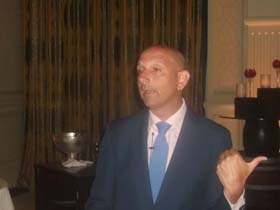 The main grape of Chianti Classico (or Chianti for that matter) is Sangiovese. It’s low in pigment, high in acid and relatively low in acidity. The wines had intense floral aromas, ripe tannins, chocolate and coffee; very drinkable wines. According to Giorgio, the 2-5% of Cabernet added to their Sangiovese gave it the colour, spiciness, a bit of cassis flavour, some tannins and made it ageworthy. He also informed us that since 1999 they had stopped making Chianti Classico Reserva as their regular Chianti Classico already had similar characteristics. He also emphasized that unlike their competitors they are very concerned about Brettanomyces (Brett). Despite double decanting, the 1998 kept on opening in the glass. I felt the 2008 was still young. The 2006 was a very pleasant wine-and seemingly popular on the palates of many people but I found the 2004 to be the best. But all the wines were so fresh, brilliant and balanced that finishing off a bottle with a friend would be the easiest and most pleasant exercise. The main grape of Chianti Classico (or Chianti for that matter) is Sangiovese. It’s low in pigment, high in acid and relatively low in acidity. The wines had intense floral aromas, ripe tannins, chocolate and coffee; very drinkable wines. According to Giorgio, the 2-5% of Cabernet added to their Sangiovese gave it the colour, spiciness, a bit of cassis flavour, some tannins and made it ageworthy. He also informed us that since 1999 they had stopped making Chianti Classico Reserva as their regular Chianti Classico already had similar characteristics. He also emphasized that unlike their competitors they are very concerned about Brettanomyces (Brett). Despite double decanting, the 1998 kept on opening in the glass. I felt the 2008 was still young. The 2006 was a very pleasant wine-and seemingly popular on the palates of many people but I found the 2004 to be the best. But all the wines were so fresh, brilliant and balanced that finishing off a bottle with a friend would be the easiest and most pleasant exercise.
The floral aromas were so intense that even when the glasses were empty - it took a sip and a half to do that - the residual bouquets kept on enticing till the waiter took the glasses away for the next flight. The light vegetable stew covered in a golden crust was reminiscent of the Cuisine of Rome and around, where soups served in a bowl covered with a thick and flaky golden crust are simply divine. Though vegetarian, it went so well with the Chianti that I immediately convinced the server to repeat if for my dessert.
Camartina 2007, ’04,’99,’96
As it turned out, it was a wise decision. The Cabernet - dominated (70%) Super Tuscan with 30% Sangiovese is a very seductive and sexy wine with little basic difference in the homogenous, balanced and elegant wine that had intense perfumes and complex flavours of dark cherries, chocolates, truffles. Even the 2007 was very approachable.
Querciabella makes only 1200-1500 cases of this wine and only in good years. Top grapes are picked from.
But serving with dessert, a generous portion of what looked like 2500 calories of delicious pleasure, was a total mismatch with the Super Tuscan which was better enjoyable by itself. However, as Giorgio explained, the purpose was to have the guided tasting of the 4 wines of ’07,'04,’99 and ’96 before digging into the dessert. But due to a short pause before the dessert that allowed the guests to intermingle, similar to the break between Acts in an opera, the comeback was slower and the dessert had been served before the wine was tasted. He implied that the wine was not supposed to be paired with the dessert.
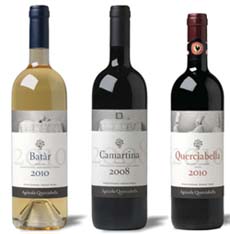 One of the objectives of such vertical tastings is to give the tasters an idea of different vintages and how the vagaries of nature affect the characteristic in a year. It is also to emphasize that wines are a true expression of the terroir. It is also a subtle way of showing age–worthiness of the wines. A perfectly drinking 14-year old Burgundy-like Batar, a Chianti Classico going back 12 years and showing it has not yet reached the middle age and of course, the 16-year young Camartina, are perfect examples of the wine making expertise and commitments of Querciabella. The current owner, Sebastiano Castiglioni and his team, including the winemaker Guido de Santi, with whom I tasted 4 years ago at Vinitaly, truly validate the philosophy of Vishal Kadakia, the owner of Wine Park. Not only does he deal with the top estates globally, he seems to be living proof that selling high quality wines is a sustainable business model. One of the objectives of such vertical tastings is to give the tasters an idea of different vintages and how the vagaries of nature affect the characteristic in a year. It is also to emphasize that wines are a true expression of the terroir. It is also a subtle way of showing age–worthiness of the wines. A perfectly drinking 14-year old Burgundy-like Batar, a Chianti Classico going back 12 years and showing it has not yet reached the middle age and of course, the 16-year young Camartina, are perfect examples of the wine making expertise and commitments of Querciabella. The current owner, Sebastiano Castiglioni and his team, including the winemaker Guido de Santi, with whom I tasted 4 years ago at Vinitaly, truly validate the philosophy of Vishal Kadakia, the owner of Wine Park. Not only does he deal with the top estates globally, he seems to be living proof that selling high quality wines is a sustainable business model.
Querciabella Batar sells for Rs.8,400, Chianti Classico for Rs.12,000, Camartina at Rs.26,000 (taxes and gratuity extra) at the Leela Delhi. While they may not be everyone’s bottle of wine, one would not be disappointed drinking these wines - at least the 14 we tasted during the magical evening. The newly launched Mongrana 2009 retails for Rs.2600 in Mumbai and should be affordable for connoisseurs looking for a Super Tuscan that does not burn a hole in the pocket.
Subhash Arora
For an earlier article on Batar, please click Wine Feature - Tuscan Batar from Querciabella |